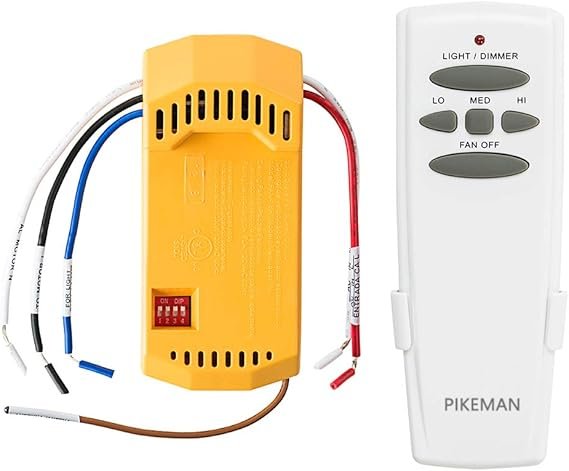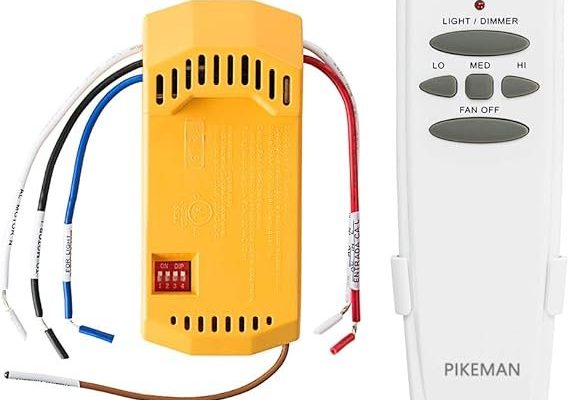
Ceiling fan remotes seem straightforward, right? Press a button, the fan spins. But behind the scenes, there’s a tiny world of codes, pairing, and sometimes—a not-so-obvious gadget called a *receiver*. Let me break it down for you, especially if you’re new to the world of Westinghouse ceiling fans or just tired of messing with pull chains. Here’s what you need to know before you start hunting for batteries or fumbling with the remote.
How Westinghouse Ceiling Fan Remotes Actually Work
You’d think a remote just “talks” directly to the fan like a walkie-talkie, but there’s an important middleman in this conversation: the receiver. Westinghouse ceiling fan remotes aren’t magic—they transmit a signal (usually radio frequency) when you press a button. But unless the fan has a *receiver* installed, there’s nobody home to hear that message.
The receiver is a small electronic box, usually hidden inside the fan’s canopy (right above the blades where everything mounts to the ceiling). Every time you hit a button to change the speed or turn on the light, the remote sends a specific code. The receiver is programmed to *catch* this code, decode it, and then tell the fan’s motor or light to do what you’ve asked.
Honestly, it’s like a game of telephone: the remote whispers the command, the receiver listens and passes it along, and the ceiling fan does its little dance. No receiver? The fan just sits quietly—and no amount of remote button mashing will get a response.
Why a Receiver Is Essential for Westinghouse Remote Control
Here’s the thing: *most* ceiling fans, including Westinghouse models, aren’t born with remote compatibility out of the box. The remote and the fan need a shared language, and that language comes in the form of paired codes managed by the receiver. The receiver also handles all the communication between remote and fan, from speed settings to light dimming.
You might be wondering, “Can’t I just buy a universal remote and skip the receiver?” Not really. Even universal remotes need to sync with a receiver that’s installed in your fan. If there’s no receiver, the remote has nothing to connect to—kind of like having a TV remote without a TV. It looks official, but it doesn’t do anything.
Some new fans *do* come with everything pre-installed, but many require you to add the receiver yourself, especially if you’re upgrading an older unit or buying a remote kit separately. Always check your Westinghouse fan’s manual. If it was designed for pull chain control, you’ll need to add a receiver to use any remote.
Identifying if Your Westinghouse Fan Has a Receiver
Before you start taking things apart or ordering parts you might not need, let’s make sure your fan already has a receiver. Here’s a quick way to check:
- Does your fan have a remote already? If yes, it probably has a receiver. (Sometimes remotes get lost, but the receiver remains snug inside the fan.)
- Do you see a small plastic box inside the canopy? When you take off the canopy cover, look for a box with wires leading to the fan and wiring from the ceiling. That’s your receiver.
- Check the manual or product specs. Many Westinghouse models specify if they’re “remote-ready” or have “receiver included.”
- Look for remote control functions on the fan itself. Some fancy fans have both wall and remote controls. If there’s a wireless setup, there’s almost always a receiver involved.
Sometimes, even if the receiver is there, it can lose sync or need to be reset. If the fan used to work with a remote but stopped, try replacing the batteries, resetting the code (check for DIP switches), or re-pairing the remote according to the manual. It’s not always a hardware problem—sometimes the solution is as simple as a new battery or a quick sync.
Step-by-Step: Installing a Westinghouse Ceiling Fan Receiver
Let me walk you through what actually happens if you need to add a receiver to your Westinghouse ceiling fan. Don’t worry—if you’ve ever changed a lightbulb, you can handle this with a little patience.
- Turn off the power at the circuit breaker. Seriously, don’t skip this. Electricity isn’t forgiving.
- Remove the canopy cover at the ceiling mount. You’ll usually need a screwdriver. Set the screws aside somewhere safe (your pocket, a cup—just not in the couch).
- Locate the wires coming from the ceiling and going into the fan. The receiver will fit in between these connections, with labeled wires to guide you. Typical receivers are marked for “fan,” “light,” and “power.”
- Connect the corresponding wires using wire nuts. Normally, you’ll match black (fan), blue (light), and white (neutral), following the receiver’s instructions. *Double check every connection.
- Tuck the receiver and wires back into the canopy carefully. Receivers aren’t big, but ceiling fan mounts can feel cramped. Be gentle so you don’t pinch any wires.
- Reattach the canopy and restore power. Grab your remote, install fresh batteries, and try pairing or syncing according to your kit’s instructions.
If it doesn’t work the first time, don’t panic. Double-check the code settings, make sure the receiver sits snugly, and that all wires are secure. It’s a bit fiddly, but once you get it right, you’ll wonder how you ever lived without remote control.
Troubleshooting Common Westinghouse Remote and Receiver Issues
Even when everything is installed correctly, things can sometimes go sideways. Here’s what usually trips people up with Westinghouse ceiling fans and remotes:
- The remote isn’t working at all. First, try new batteries. If that doesn’t help, check if there’s a tiny reset or sync button inside the battery cover—press this to pair it again with the receiver.
- The fan or light works with the pull chain but not the remote. This usually means the receiver isn’t getting power or isn’t wired correctly. Double-check those connections.
- The fan works, but the light doesn’t (or vice versa). Sometimes one wire comes loose or is in the wrong spot. Also, check your bulbs—sometimes it’s just a burnt-out bulb fooling you!
- The remote only works from up close. Weak batteries, interference from other electronics, or a receiver tucked too far back can all cause this. Fresh batteries and some receiver repositioning usually help.
If your remote suddenly stops working after a power outage, try resetting both the remote and receiver. Sometimes, a surge can scramble their “conversation.”
One more tip: If your neighbor has the same fan and remote, you might accidentally control each other’s fans (yep, it happens). Check the DIP switch codes on both the remote and receiver—they should match only for your setup.
Pairing, Resetting, and Syncing Westinghouse Remotes and Receivers
The code that lets your Westinghouse remote “talk” to the receiver is either set with physical DIP switches inside both the remote and receiver, or with a pairing sequence (button press + power on) for newer models. Here’s how to handle each scenario:
- DIP switch models: Open the battery cover on the remote and the receiver’s case (if you have access—sometimes you’ll use the manual for this). You’ll see a set of tiny switches—set them to the same pattern on both devices.
- Pairing button models: Hold down the pairing button on the remote, then turn the fan’s power back on. Keep holding the button until you see the fan or light react (blink, spin, etc.).
- Resetting: If the remote and receiver lose sync, repeat the pairing steps or try a complete power cycle—turn everything off, wait a minute, and start fresh.
You might run into confusion if you upgrade just the remote or receiver without matching tech. Westinghouse remotes and receivers are designed to work together as a set—mixing parts from different brands or generations can lead to those annoying “nothing happens when I press the button” moments.
Universal Remote Control vs. Westinghouse Original Remote
Curious about swapping out your Westinghouse remote for a universal one? Here’s where things get a little tricky. Universal remotes seem appealing for controlling multiple fans, but you still need a compatible receiver in each fan. The universal remote *talks* to the receiver, just like a brand-specific one.
Let me explain: if your Westinghouse fan has a working receiver (universal or original), most universal remotes designed for ceiling fans will pair and control basic functions—on/off, speed, light. But if the receiver inside the fan is too old, or if it uses a code system that isn’t supported by your universal remote, you might only get limited functions (or none at all).
Bottom line: the magic always happens because of the *receiver*. Remotes, universal or not, are only as useful as the hardware they’re paired with. If you’re hoping to control multiple fans with one remote, every fan still needs its own receiver, and those receivers must be compatible with the remote you choose.
When a Remote-Controlled Ceiling Fan Makes Sense
So, is all this effort worth it? For most people, absolutely. With a Westinghouse remote setup (and the right receiver in place), you can:
- Change fan speeds without leaving your bed or couch
- Turn the lights on and off with a tap—no hunting for pull chains in the dark
- Set up timers or dim the lights (on compatible models and receivers)
- Control multiple fans if your home is set up for it
If you have tall ceilings or fans in hard-to-reach spots, a remote is more than just a convenience—it’s almost a necessity. And with sync, pair, and reset functions, you’ll rarely be left in the lurch if something goes wrong.
The right setup means you’ll barely think about it—your fans and lights become part of the room’s rhythm, quietly doing their job.
Just remember: the key is always the *receiver*. If your Westinghouse fan doesn’t have one, the remote alone is just a fancy paperweight.
Final Thoughts: Receiver and Remote—The Dynamic Duo
Using a Westinghouse ceiling fan remote without a receiver is a bit like trying to call someone who doesn’t own a phone. The fan and remote *need* that receiver to communicate. Whether you’re installing a new ceiling fan, upgrading an old one, or troubleshooting a fussy system, always check for that crucial receiver tucked away in the canopy.
If you’re ever in doubt, open up the manual or peek under the hood—sometimes the answer is one screw away. And once you’ve got your remote and receiver working in harmony, that pull chain will feel as outdated as a rotary phone.
Here’s hoping your ceiling fan setup is as breezy as it should be—smooth, responsive, and totally in sync.
